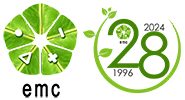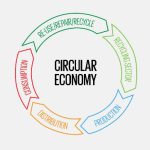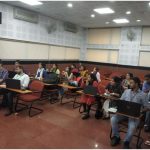This January my consulting company Environmental Management Centre Pvt. Ltd. completed 25 years! I am writing this post today to share my experience in this journey. This story telling may help young entrepreneurs entering the profession of environmental management.
I left my full-time teaching position at the Indian Institute of Technology, Bombay to establish EMC. I was 40 years old then and wanted to do something different. I don’t think making money or growing in size and in turnover were the motives of EMC. EMC always remained a boutique consulting company and did not become a Corporation. We began with a team of 3 and today all people counted we are around 20.The company operates as a family. I have been very fussy in inducting people on our Team.
It is important to set the definition of growth when you set your organization. For a person like me who always wanted to be involved in multiple roles and enjoy wearing different hats, EMC was another important “experiment”. However, EMC remained close to my heart. It became my identity. I always looked at Team EMC as if it was a master’s class of students I used to teach at the Indian Institute of Technology. So, the consulting work EMC did, was by a Professor of Practice and the Team.
In 1996, I wrote EMC’s mission as “Practicing Sustainability to the Advantage to All”. Looking back now, I realize that I had used the term sustainability much earlier. At that time, sustainability was not the buzz word as it is (overly) used today. The mission statement emphasized that practicing or mainstreaming sustainability can be smart to give an advantage to all. “To All” was an important term in the mission statement as it included even our competitors! You must think big to ensure a healthy competition.
Over the past 25 years, EMC completed more than 500 assignments in India and across the world. We worked with Governments, Corporates, Financing Institutions, Research bodies and Community based Organizations. The portfolio has been thus rich and diverse. “National roots with international experience” was perhaps selling point of EMC. Most of the times, we were sole sourced and enjoyed the support of “repeat clients”. We could build long term relationships, almost like an extended family.
Every assignment we worked on was unique and different. We couldn’t possibly use a templated approach. I personally don’t enjoy work when it becomes routine. So, each project was a discovery, delivered on the basis of “evolving terms of references” (as both client and consultant were learning). In this process, we came up with several “firsts”. Due to my travels and multiple roles in the environmental profession, I could never get a bandwidth to publish all these innovations in our consulting practice. Innovations in consulting generally do not get published.
I am now planning to publish an “EMC Coffee Book” presenting the case studies built on EMC’s assignments and experience. This Coffee Book will not be a marketing publication of EMC but more of an expression of experience – sharing innovations to inspire young consultants, businesses, investors and regulators.
Internship in the career matters. I conceived “EMC Internship Program” in 2004. Internship at EMC is taken seriously with thorough mentoring. By now, more than 100 interns have taken benefit of being with EMC. Last year we conducted a tracer study on EMC interns and the feedback was simply overwhelming. Internship at EMC is really sought for. We receive around 200 applications in a year and we accept only 4 to 5 interns after a careful evaluation. Interns helped EMC by becoming “EMC Ambassadors”. More importantly the internship program created important institutional linkages that EMC could leverage on.
In the course of last 25 years, nearly 100 professionals moved out of EMC to further their careers. Some set up their independent businesses, drawing inspiration from the work at EMC; some took up advanced studies and some relocated elsewhere in India and overseas. All these colleagues, whom we call as “EMCians” are still connected. Today we operate a “What’s App group” for EMCians. This is yet another example of an extended EMC Family. Sometimes I feel that our repeat client’s network, EMCians What’s App group and EMC’s Internship Program are the true impact indicators of organizations like EMC.
When we talk about impacts, it is important to follow up to check whether the consulting work made any difference. Did it influence policies, introduced new methodologies or developed tools to improve practice for effective outcomes? For an environmental company, giving statistics on number of environmental clearances obtained is perhaps not the true outcome indicator. So, I introspected our 500+ assignment portfolio and found that only 10% of the work we did, resulted in the “intended or desired change”. In most cases, impacts could not be harvested because of organizational inertia at clients end, or because the administrator in charge got transferred elsewhere or because there were challenges on mobilizing the financial resources. This experience has been rather frustrating. This is where you need a political support with leadership that looks beyond and not limit the vision and mission to a 5-year period!
It is important to create a “market” for environmental services not just for achieving compliance, but also for building competitiveness of the business by going beyond compliance – essentially “smart sustainability”. We also need to build “capacities to deliver”. Consulting companies can play an active role in this endeavor, but unfortunately very few consulting companies are engaged to take this on as a “professional responsibility”. In 2009, I made a deliberate effort to support awareness and training programs in environmental management through EMC. We funded these activities from our own budgets, cutting down our profits. We did not seek any grant or external funding.
I believe and firmly so that such an exposure (i.e., working for a “non-billable” activity) is necessary for the personal growth of the Team. By working on community initiatives, you bring in the sensitivity and empathy in the work you do and become a responsible and ethical environmental consultant. Today, this work of EMC is housed under a not for profit – Section 8 company – Ekonnect Knowledge Foundation that we set up in 2012. In the last 10 years, Ekonnect has grown and is making a significant contribution to build capacities and promote eco-entrepreneurship in India as well as overseas. Team EMC continues to support Ekonnect.
Many ask me “tell us which consulting assignment excited you the most?” Honestly, it is difficult question to answer for any professional. But I must end this post by telling you a story.
One of the large glass manufacturing company near Mumbai, asked me to spend some time at their manufacturing plant. I asked the CEO what is it that you expect me to do. The CEO said, reach the plant early by 9 am, walk around and meet me for a short chat post lunch. Stay with us for 5 days. I agreed to this weird assignment as I was curious.
On the first day, the CEO introduced me to his department heads and told them that I will be doing a walk through and their teams should provide me any information or answer questions. In closing the meeting, the CEO said that he expects a handwritten page each day. “Dr Modak, write in bullets and with a large size font please.”
I walked around on the first day and met the CEO post lunch. I handed over to him a page of my observations and suggestions. The CEO took a good look at the page and asked me a few questions. The conversation ended in just 15 minutes. The next day I continued my walk through and met the CEO with another one pager. When I reached his cabin, I saw that there were two department heads with him – the departments I had visited in the two days. The CEO had on his desk the one pager I had given for Day 1. He had made remarks on items I had listed. I saw some scribbling was done.
“Well Dr Modak, many of your suggestions were relevant. We have already implemented four out of seven and are getting immediate benefits. One of your suggestions is not practical. Remaining two suggestions are good but will need some preparatory work.” I was amazed to see how focused and action oriented the CEO was.
On the fifth day, the CEO called for a closing meeting with all the department heads. He summarized my suggestions and actions that were immediately taken and those that will be implemented in the next 3 months. He asked for close monitoring to assess the impacts of actions taken considering savings, emission reduction and workspace safety. At the end, he thanked me for my time.
“What about submitting a report Mr CEO?” I asked after the meeting was concluded.
No need of a report, Dr Modak, said the CEO.
Those were perhaps the best moments in a consultant’s life.
I wish I get to do more such assignments in the next 25 years with EMC!
Write to us at emcblogs@emcentre.com if you are interested to know more about this project. Let us know if can be of any help to you.






